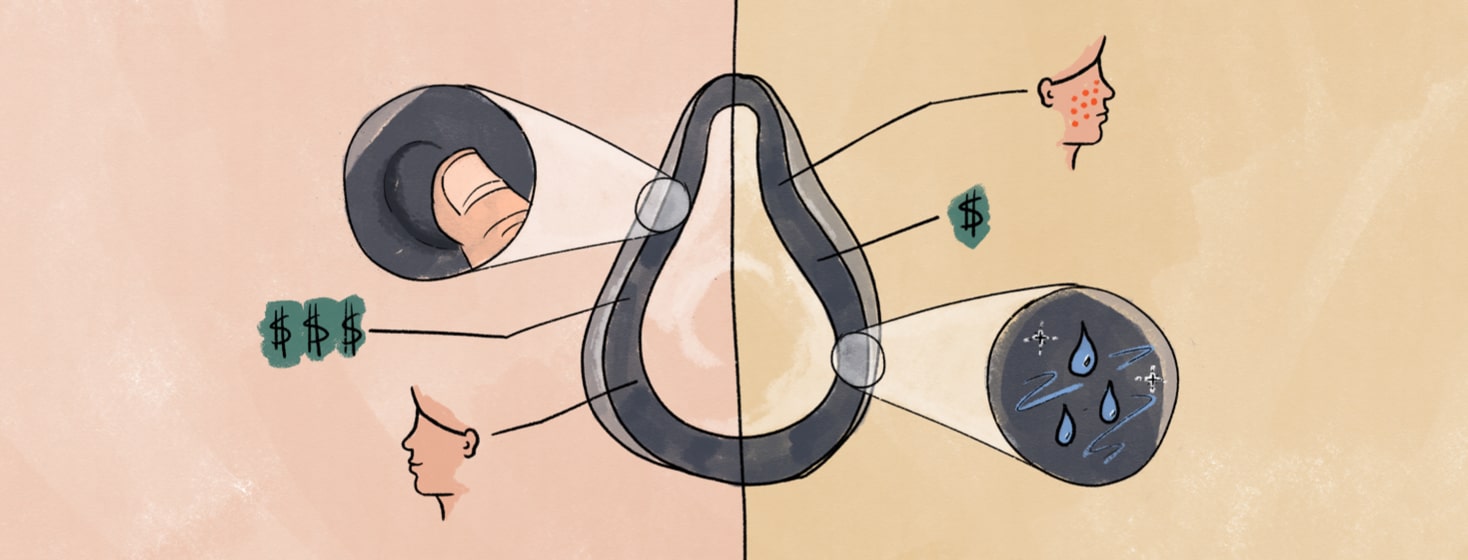Silicone or Memory Foam Cushion? It Depends
One of the things you have to do as a CPAP user who needs a full-face mask is figure out the right cushion for you. The cushion is the piece that goes directly against your face and creates the seal.
When I first started using my ResMed AirSense 10 CPAP, the equipment supplier gave me the silicone-based AirFit F20 cushion. (Unfortunately, the cushion was the wrong size because my supplier didn’t measure me – something you can read about in another article.)
Using a silicone cushion
That’s all that I thought was available, so I worked with it. Although I was able to adapt to wearing the CPAP as a whole very quickly, I found the feeling of silicone against my skin unpleasant.
Sweat and saliva seemed to seep beneath it overnight and cause a skin rash. Pulling it tighter to keep moisture on one side or the other helped but also left deep ruts in my face by morning.
Trial and error with mask liners
I looked into buying mask liners but balked at the negative reviews I kept encountering. People complained about the price for what was essentially just a piece of cloth with a big hole cut in it!
So, I tried making some myself, experimenting with old T-shirts and dishcloths. I found they didn’t really stay in place when I tossed and turned. But they did absorb some of the nasty moisture and prevented the ruts.
Eventually, I just gave up and started stuffing Kleenex around the lower edges when I went to bed – not a great look, but it did the job.
Trying a memory foam cushion
Then one month, I ordered what I thought was the AirFit F20 cushion, but apparently made a mistake and selected the AirTouch R20 instead. When I opened the package, I was surprised to see a rim of memory foam on top of a silicone base. When it fit my mask headgear, I decided to give it a try.
Wow! What a difference! For once, I woke up without a skin rash, and the seal was excellent. I still had to deal with the various bodily fluids, but instead of pulling and pinching at my face, the memory foam felt soft. I’ve used this model ever since.
No cushion is perfect
Of course, no solution is perfect. For instance, memory foam feels nice against the skin but can’t be washed in water. I didn’t read the instructions and tried washing my first one, as I routinely had with the silicone cushions. It deteriorated into a slimy mess that had to be trashed.
Also, the foam does absorb some moisture, and that changes the texture – not just bodily fluids, but things like skincare products as well. Spit can make it a bit slimy and cold; I discovered that antibiotic lotion leaves the foam orange and slightly crusty.
Comparing silicone vs memory foam
I did a pro/con list of the 2 cushion materials. Keep in mind these are my observations, not product claims:
AirFit F20 (Silicone)
Pros:
- Can be washed with mild soap and water (so, easier to care for, and lasts somewhat longer as a result)
- Doesn’t seem to be affected by use of skincare products
- Less expensive (in my experience)
Cons:
- Must be tight for consistent seal, which can irritate the skin
- Bodily fluids can seep under, irritating the skin
- Can tear at the split
AirTouch R20 UltraSoft™ (Memory foam)
Pros:
- Comfortable against the skin, even when tight
- Good seal, especially when new
Cons:
- Must not come in contact with water/fluids (though can be cleaned somewhat using special wipes)
- Performance degrades over course of a month
- Foam can be stained/damaged by skincare products
- More expensive
I’ve decided to stick with memory foam cushion going forward, even with its drawbacks. What type of cushion do you prefer, and why? Share your answers in the comments!

Join the conversation